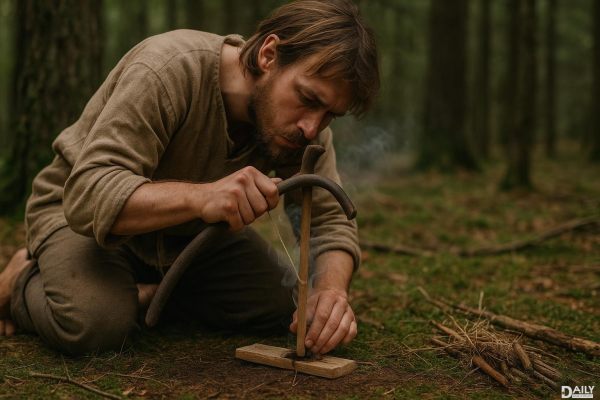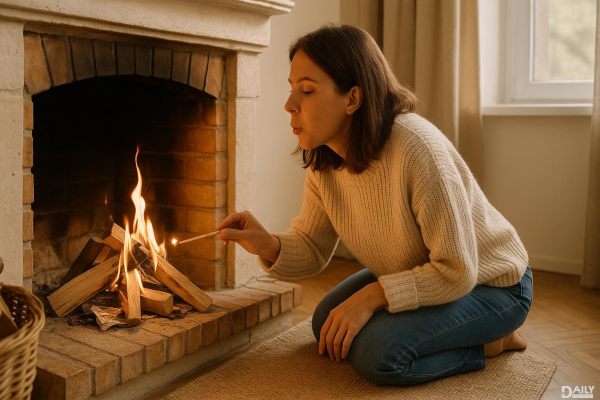Our ancestors didn't have matches or lighters, yet they mastered the art of fire-making like absolute bosses. They used friction, sparks, and sheer ingenuity to create one of humanity's most crucial survival tools. Let's break down how these primitive MacGyvers turned sticks and stones into life-saving flames.

Before Bic lighters became a thing, early humans had to get creative with their fire-starting game. Archaeological evidence shows our hominid ancestors were playing with fire as far back as 1.7 million years ago. The controlled use of fire literally changed the course of human evolution - allowing for cooked food (goodbye, parasites), warmth (so long, frostbite), and protection from predators (take that, saber-toothed cats). These primitive pyros developed multiple techniques across different cultures, each method fine-tuned to their environment and available materials.
The hand drill method was the CrossFit of the Stone Age - brutal but effective. You'd take a straight, dry stick (the drill) and rub it like crazy against a flat piece of wood (the hearth) using your palms. The trick was maintaining perfect downward pressure while spinning the drill rapidly enough to create glowing embers. Blisters? Guaranteed. Success? Not so much - unless you had the technique down pat. Our ancestors typically used softwoods like cedar or willow that created fine, combustible powder when ground down. The real pros could get a fire going in under a minute, while most modern survivalists need at least 5-10 minutes of furious rubbing.
Some clever cave-dweller eventually got tired of raw palms and invented the bow drill - the first major innovation in fire-starting tech. This game-changer used a simple bow (like a miniature version of what you'd use for archery) to rotate the drill, allowing for faster spinning with less effort. The setup included a handhold (usually a stone or piece of bone with a depression), the bow, the drill, and the hearth board. When done right, the bow drill could generate enough friction to produce an ember in half the time of the hand drill. This method was so effective that some indigenous cultures still use it today when modern tools aren't available.
Before the Iron Age, our ancestors discovered that certain rocks could produce sparks when struck together. The real magic happened when they paired high-carbon steel (which became more available around 1200 BCE) with flint or quartz. Striking the steel against the stone at just the right angle would send superheated metal particles flying into your tinder bundle. This method worked in wet conditions when friction fire techniques would fail, making it a favorite among European explorers and Native American tribes. The downside? You needed to carry special materials, unlike friction methods where you could often find what you needed in nature.
In tropical regions where softwoods were plentiful, the fire plow became the go-to technique. This involved taking a hardwood stick and plowing it back and forth along a groove in a softer wood base. The constant back-and-forth motion would eventually produce enough heat and fine powder to create an ember. While less efficient than bow drilling, the fire plow had one major advantage - it was simple enough that a single person could maintain the motion indefinitely without needing to stop and reset like with other methods. Pacific Islanders perfected this technique, often using the wood of the hau tree for its ideal friction properties.
All the friction in the world won't help if your tinder sucks. Our ancestors became master foragers, knowing exactly which materials would catch and hold a spark. Dry grass, birch bark, cattail fluff, and certain fungi were all prime candidates. The real pros would create "tinder nests" - carefully prepared bundles of ultra-dry, finely shredded material that could catch the faintest ember and be gently blown into flame. Some cultures even carried pre-made tinder in waterproof containers, showing how seriously they took this crucial element of fire-making.
Today's wilderness experts still practice these ancient techniques, both as a survival skill and to connect with our ancestral roots. While we've got lighters and ferro rods now, knowing how to make fire the old-fashioned way could literally save your life if you're ever stranded without modern tools. The next time you effortlessly flick a lighter, take a second to appreciate the generations of trial-and-error that went into mastering this fundamental human technology.
These primitive fire-making methods represent more than just survival skills - they're a testament to human creativity and perseverance. Our ancestors didn't just stumble upon fire; they mastered it through countless generations of experimentation and refinement. That burning curiosity to solve problems with whatever materials were available? That's the same innovative spirit that eventually led to smartphones and space travel. So the next time you're camping, try rubbing some sticks together - you'll gain a whole new respect for how tough our ancestors really were.
























